| South African Class 8E | |||||||||||||||||||||||||||||||||||||||||||||||||||||||||||
|---|---|---|---|---|---|---|---|---|---|---|---|---|---|---|---|---|---|---|---|---|---|---|---|---|---|---|---|---|---|---|---|---|---|---|---|---|---|---|---|---|---|---|---|---|---|---|---|---|---|---|---|---|---|---|---|---|---|---|---|
 No. E8002 at Mandini, KwaZulu-Natal, 13 August 2007 | |||||||||||||||||||||||||||||||||||||||||||||||||||||||||||
| |||||||||||||||||||||||||||||||||||||||||||||||||||||||||||
| |||||||||||||||||||||||||||||||||||||||||||||||||||||||||||
| |||||||||||||||||||||||||||||||||||||||||||||||||||||||||||
| |||||||||||||||||||||||||||||||||||||||||||||||||||||||||||
The South African Railways Class 8E of 1983 is an electric locomotive.
Between 1983 and 1985 the South African Railways placed one hundred Class 8E centre-cab electric locomotives with a Bo-Bo wheel arrangement in shunting service. Seven more were built for the mining industry.[1][2]
Manufacturer
As a result of the gradual withdrawal of steam locomotives from service, many of which had been employed as shunting engines, and in addition to the Classes 36-000 and 36-200 diesel-electric locomotives, a growing need arose for a modern electric shunting locomotive for the South African Railways (SAR), especially for use in yards in the large 3 kV DC electrified centres where the Class ES and Class 1ES locomotives were also due to be withdrawn.[3]
The Class 8E electric shunting locomotive was designed for the SAR by a consortium consisting of Brown Boveri of Switzerland and Siemens of Germany. It was built by Union Carriage & Wagon (UCW) in Nigel, Transvaal, who also fabricated the mechanical components.[2][4]
One hundred locomotives were delivered by UCW to the SAR between 1983 and 1985, numbered in the range from E8001 to E8100. Another seven units were built by UCW for the mining industry. UCW did not allocate builder's numbers to the locomotives it built for the SAR, but used the SAR unit numbers for their record keeping. The locomotives which were built by UCW for industry, on the other hand, were allocated works numbers.[1][2]
Orientation and features
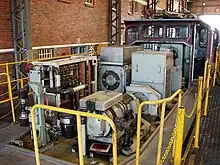

The centre cab Class 8E has large grilles on the sides of both hoods on one side and a grille on the side of only the left hand side hood when viewed from the other side. The no. 1 end will be at the viewer's left when observing the locomotive from the side with grilles on both hoods.[1]
The pictures alongside of no. E8008 with both hood covers removed, illustrate the different equipment installed inside the two ends of the locomotive.
The locomotive has solid state electrical control circuitry with a thyristor-controlled chopper supplying the four traction motors. Since the conventional accelerating resistors could be omitted which are used on mainline electric locomotives, considerable energy saving was accomplished on heavy shunting duties.[3]
The bogies are based on those of the Class 6E, but with a rubber secondary suspension system which provides maximum adhesive force to the locomotive when starting from rest. The locomotive was designed to be operated by a crew of one and has two driving stations in the cab.[3]
Service
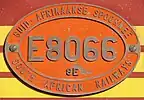
The Class 8E was initially placed in service on the Witwatersrand, but a large number of them were later allocated to Durban and to other locations in Natal. Some are also employed at Beaconsfield in Kimberley, at Postmasburg in the Northern Cape and at Nelspruit in Mpumalanga. Apart from a short period in the early 1980s when one served as the station pilot in Cape Town, working between the mainline platforms at Cape Town station and the passenger carriage yard at Culemborg, the Class 8E is unknown in the Western Cape.[3]
They are powerful shunters and popular with their drivers, even though problems are sometimes experienced with start-up or failures while working at coastal centres such as at Umbilo in Durban. This is attributed to the damp climate which causes start-up contacter failures. Beginning in 2007, they were gradually equipped with air conditioning units for added crew comfort, similar to those installed in the Class 18E. The air conditioning unit is mounted on the running board to the right of the cab on the right hand side of the locomotive.[1]
Industrial use
At the same time that the Class 8E locomotives were being built for the SAR, another seven were built for the mining industry.
- Three were built for Driefontein Consolidated Gold Mine (Dries) near Carletonville, numbered in the range from 5 to 7 and with builder's works numbers in the range from 449145 to 449147. Of these, Dries no. 5 was withdrawn and scrapped after an accident, with the remains dumped at the mine.
- Four were built for the Impala Platinum mine (Implats) at Phokeng near Rustenburg, numbered 11, 12, 14 and 15, with builder's works numbers 449143, 449144, 449148 and 449149. In addition to these, seven SAR Class 8E locomotives, numbers E8005, E8006, E8019, E8026, E8042, E8050 and E8060, were later sold to Implats.[2]
Liveries
All the Class 8E locomotives were delivered in the SAR red oxide livery with signal red buffer beams and cowcatchers, yellow whiskers and with the number plates on the cab sides mounted on three-stripe yellow wings. In the 1990s some of them were repainted in the Spoornet maroon livery with a yellow and blue chevron pattern on the buffer beams and cowcatchers. In the late 1990s many were repainted in the Spoornet blue livery with either solid or outline numbers on the long hood sides.[5]
Illustration
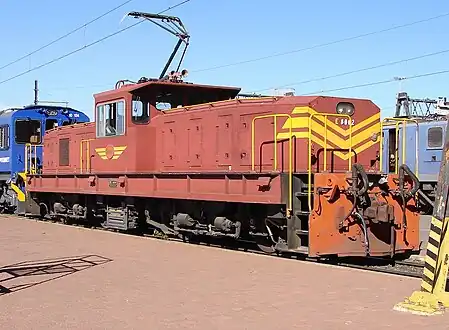 No. E8062 in SAR Gulf Red and whiskers livery at Beaconsfield, Kimberley, 17 September 2009
No. E8062 in SAR Gulf Red and whiskers livery at Beaconsfield, Kimberley, 17 September 2009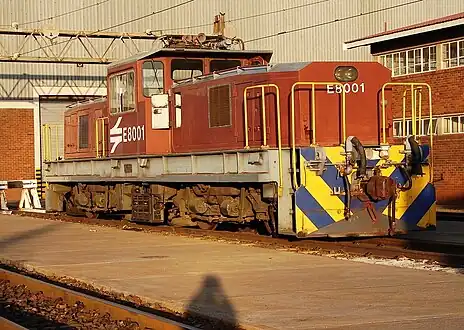 No. E8001 in Spoornet maroon livery at the Sentrarand loco depot in Gauteng, 8 October 2009
No. E8001 in Spoornet maroon livery at the Sentrarand loco depot in Gauteng, 8 October 2009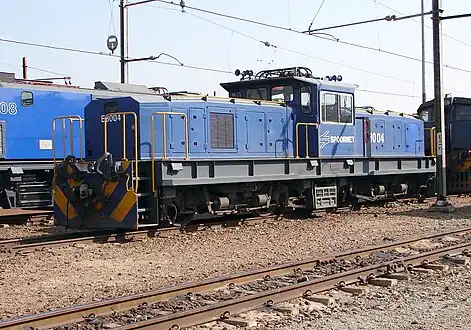 No. E8004 in Spoornet blue livery with solid numbers at the Sentrarand depot in Gauteng, 22 September 2009
No. E8004 in Spoornet blue livery with solid numbers at the Sentrarand depot in Gauteng, 22 September 2009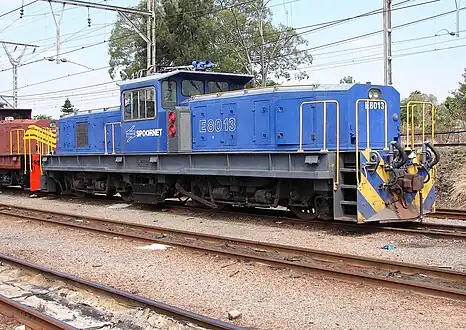 No. E8013 in Spoornet blue livery with outline numbers at Capital Park, Pretoria, 1 October 2009
No. E8013 in Spoornet blue livery with outline numbers at Capital Park, Pretoria, 1 October 2009
References
- 1 2 3 4 South African Railways Index and Diagrams Electric and Diesel Locomotives, 610mm and 1065mm Gauges, Ref LXD 14/1/100/20, 28 January 1975, as amended
- 1 2 3 4 Middleton, John N. (2002). Railways of Southern Africa Locomotive Guide - 2002 (as amended by Combined Amendment List 4, January 2009) (2nd, Dec 2002 ed.). Herts, England: Beyer-Garratt Publications. pp. 51, 59, 63.
- 1 2 3 4 Paxton, Leith; Bourne, David (1985). Locomotives of the South African Railways (1st ed.). Cape Town: Struik. p. 131. ISBN 0869772112.
- ↑ "UCW - Electric locomotives" (PDF). The UCW Partnership. Archived from the original (PDF) on 12 October 2007. Retrieved 30 September 2010.
- ↑ Soul of A Railway, System 7, Western Transvaal, based in Johannesburg, Part 9. South-Eastwards as far as Volksrust (2nd part) by Les Pivnic. Caption 4. (Accessed on 11 April 2017)
External links
![]() Media related to South African Class 8E at Wikimedia Commons
Media related to South African Class 8E at Wikimedia Commons
.JPG.webp)